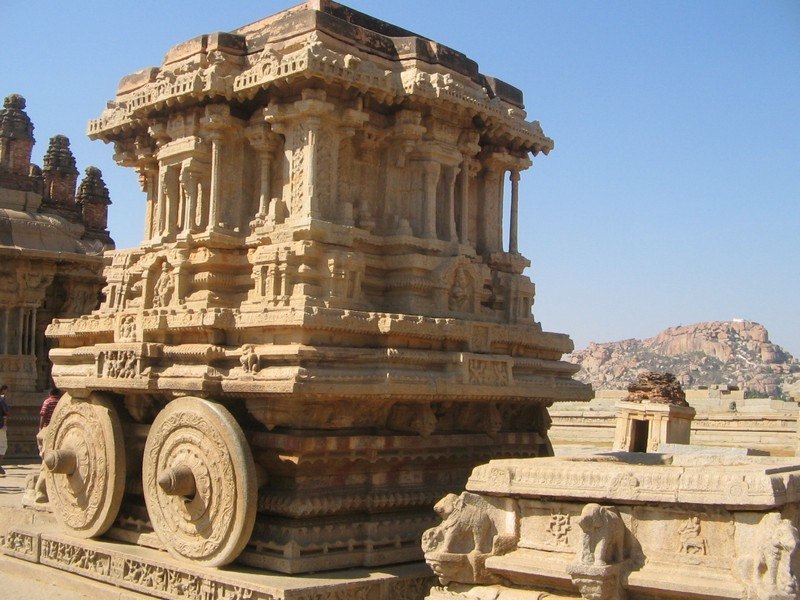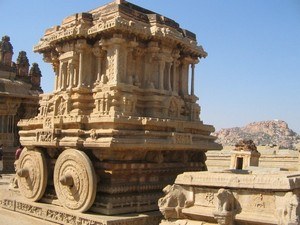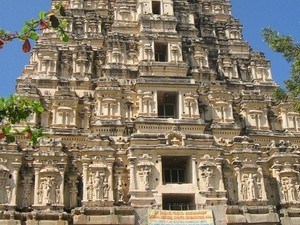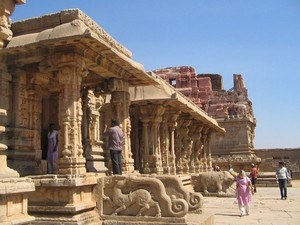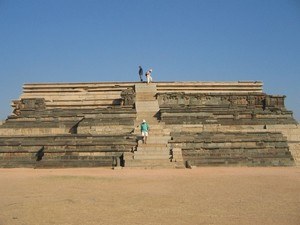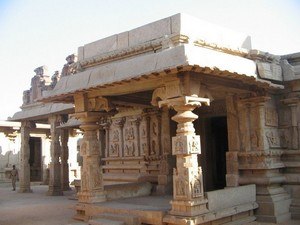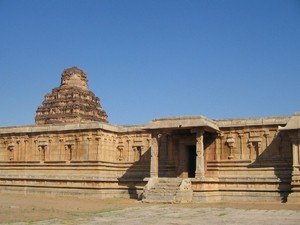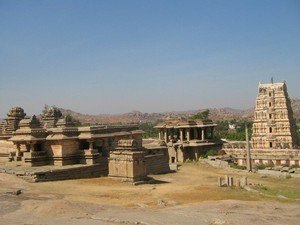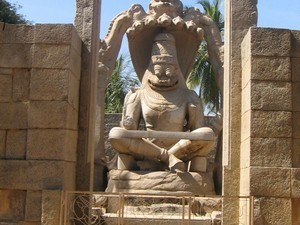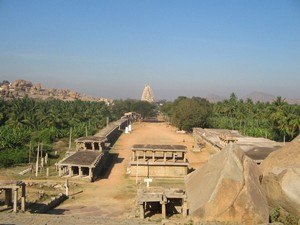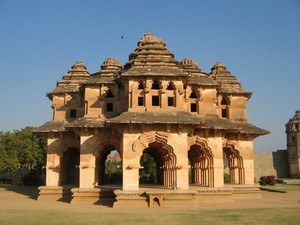Vittala Temple / Vijaya Vittala Temple, Hampi - Timings, History, Architecture, Best Time to Visit
Photo Credit: Flickr
 #1 of 37 Places to Visit in Hampi
#1 of 37 Places to Visit in Hampi
 Distance (From Hampi Bus Station): 9 Kms
Distance (From Hampi Bus Station): 9 Kms
 Trip Duration (Including Travel): 1-2 Hours
Trip Duration (Including Travel): 1-2 Hours
 Transportation Options: Cab / Auto / Rental Bike / Walk/Trek
Transportation Options: Cab / Auto / Rental Bike / Walk/Trek
 Travel Tips: Vittala temple is the venue of the annual Purandaradasa festival in January/February.
Travel Tips: Vittala temple is the venue of the annual Purandaradasa festival in January/February.
About Vittala Temple/Vijaya Vittala Temple
At a distance of 9 Km (or 2 Km by walk) from Hampi Bus Stand and 6 Km from Kamalapura Bus Stand, the Vittala Temple or Vijaya Vittala Temple in Hampi is an ancient monument located on the southern bank of the Tungabhadra River. This temple is dedicated to Lord Vishnu in the form of Vittala. The temple is well-known for its exceptional architecture and unmatched craftsmanship. It is considered to be one of the largest and the most famous structure in Hampi, among the most popular heritage sites near Hyderabad. The temple complex includes the famous Stone Chariot and the Musical Pillars.
History of Vittala Temple/Vijaya Vittala Temple
The Vijaya Vittala or Vittala Temple is the most famous places to visit in Hampi. It was built around 15th century AD during the reign of King Devaraya II (1422 - 1446 AD). Several portions of the temple were expanded and enhanced during the reign of Krishnadevaraya (1509 - 1529 AD). While the temple is partially in ruins due to attacks on the Vijayanagara Empire, it remains a significant historical and architectural landmark.
Architecture of Vittala Temple/Vijaya Vittala Temple
The Vittala Temple is built in Dravidian style and stands in a large rectangular enclosure. The three lofty Vijayanagara towers on the east, north and south are now dilapidated. The entire complex houses several temples, enclosures, pavilions and halls. In front of the temple is the world famous stone chariot or ratha. This is one of the three famous stone chariots in India, the other two being in Konark and Mahabalipuram. The Stone Chariot of Vittala Temple is actually a shrine that has been designed in the shape of an ornamental chariot for Garuda, the vehicle of Lord Vishnu. The chariot, stands on a rectangular platform, is built out of giant granite blocks. All around this base platform is carved with mythical battle scenes. A series of concentric floral motifs adorn the wheels of the chariot. The wheels of the ratha can be rotated but the government cemented them to avoid the damage caused by the visitors. Two elephants are positioned in front of the chariot but initially two horses were carved and positioned in front.
The Maha Mantapa contains four open halls within. The south, north and the east ones are still intact. The central western hall is collapsed during the attack of the Mughals that led to the downfall of the Vijayanagara Empire in 1565 AD. The Mantapa contains 56 musical pillars, 40 of which are regularly disposed to form an aisle while the remaining 16 form a rectangular court in the center. These musical pillars are also known as SAREGAMA pillars, indicating the musical notes emitted by them. The musical notes are emanated when the pillars are tapped gently.
There is a set of main pillars and several sets of minor pillars inside the Mantapa. Each main pillar provides support to the ceiling of the Ranga Mantapa. The main pillars are designed as musical instruments. Every main pillar is surrounded by 7 minor pillars. These 7 pillars emit 7 different musical notes from the representative musical instruments. The notes emanating from these pillars vary in sound quality depending on whether the instrument is a percussion, string or wind instrument. The British wanted to check the reason behind this wonder and so they had cut two pillars to check anything was there inside the pillars that were producing the sound. They had found nothing but hollow pillars. Even today visitors can see those pillars cut by the British.
The other attractions in this temple complex are the Goddess's shrine, the 100-pillared hall, the Kalayna Mantapa and the pillared cloisters all around the enclosure wall. The Vittala Temple is in a partially ruined state. The sanctum sanctorum of the temple is devoid of any idol now. The road leading to the temple was once a market where the horses were traded. Even today we can see the ruins of the market on both the sides of the road. The temple contains the images of foreigners like Persians selling horses.
Festivals of Vittala Temple/Vijaya Vittala Temple
The primary festival observed at the Vittala Temple is the Purandaradasa Aradhana, which honors Carnatic music and pays tribute to the 16th-century saint-composer Purandaradasa. This event is usually conducted in January/February and includes devotional concerts and classical performances held in proximity to the temple. Moreover, the Hampi Utsav, also referred to as Vijaya Utsav, is another significant, multi-day cultural festival that spans various regions of the ancient city, including the vicinity of the Vittala Temple. It showcases a magnificent elephant procession, cultural performances, folk dances and songs (Janapada Kalavahini), craft exhibitions, and sound and light displays, all of which contribute to a lively atmosphere.
Vittala Temple/Vijaya Vittala Temple Dress Code & Other Restrictions of
The recommended dress code for the Vittala Temple in Hampi emphasizes modest attire in accordance with Hindu customs. Men are encouraged to wear shirt & trouser, dhoti or pyjamas. Women are advised to wear sarees, salwar kameez, or other traditional clothing that adequately covers their shoulders and legs. While not strictly enforced, visitors are generally expected to avoid wearing shorts, night dresses, sleeveless tops, and ripped jeans.
Non-Hindus are generally allowed to visit and explore the Vijaya Vittala Temple in Hampi. There are no restrictions based on religion for entry into the temple complex itself, and no one will ask for your religion at the entrance.
Vittala Temple/Vijaya Vittala Temple Timings
Monday: 8:30 AM - 5:30 PM
Tuesday: 8:30 AM - 5:30 PM
Wednesday: 8:30 AM - 5:30 PM
Thursday: 8:30 AM - 5:30 PM
Friday: 8:30 AM - 5:30 PM
Saturday: 8:30 AM - 5:30 PM
Sunday: 8:30 AM - 5:30 PM
Vittala Temple/Vijaya Vittala Temple Entry Fee
Entry: Rs. 40 for Indians & SAARC/BIMSTEC Countries, Rs. 600 for Foreigners, & Rs. 25/ Videocam
Best Time to Visit Vittala Temple/Vijaya Vittala Temple
The best time to visit the Vittala Temple in Hampi is during the winter months, especially from October to February. During this period, the weather is pleasant with cooler temperatures and comfortable evenings, making it ideal for exploring the ruins and partaking in outdoor activities. Additionally, the winter months align with the Hampi Utsav (Vijaya Utsava), a cultural festival featuring folk music, dance performances, and art exhibitions, which enhances the vibrancy of your visit. The summer months can be excessively hot and arid in this area, rendering it less attractive for outdoor pursuits. The monsoon season, which spans from July to September, can result in significant rainfall, making the ascent slippery and difficult.
How to Reach Vittala Temple/Vijaya Vittala Temple
About 166 Km from Hampi, Hubli Airport is the closest airport that has direct flights from Bangalore and Mumbai. The nearest railway station is Hospet, located 13 Km from Hampi, which is well-served by trains from Bangalore, Hyderabad, Hubli, Chennai, Vijayawada, Tirupati, Panjim, Kolkata, Mysore, Ajmer, Jodhpur, Kolhapur, and Shiridi. Hampi is accessible by road through KSRTC bus services originating from Bangalore, Hubli, Goa, and Karwar. From Hampi Bus Stand, one can reach the Vittala Temple by a few minutes' walk across Thungabadra River, or by taking a cab, or auto-rickshaw.



